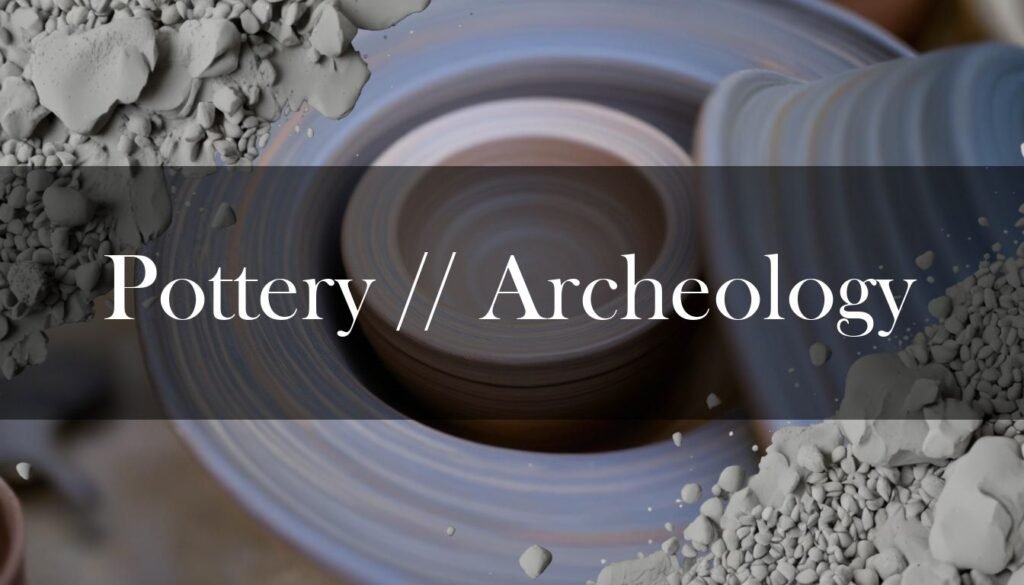Pottery is one of the most common finds in an archeological dig, providing researchers with a glimpse into the lives of people from the past. From the simplest cooking pots to ornate ceremonial vessels, pottery shards offer valuable insights into ancient cultures, technologies, trade networks, and daily life. Among the most commonly found types are earthenware, stoneware and porcelain, each with distinct characteristics and historical significance.
Earthenware is the oldest and most prevalent form of pottery, dating back as far as 29,000–25,000 BC. Typically fired at temperatures below 1,200°C, earthenware results in a porous body that often requires glazing to hold liquids. There are many subtypes of earthenware, such as terracotta and redware. For example, red- and buff-bodied earthenware vessels were commonly used from the early seventeenth through the mid-nineteenth century. These vessels were often coated with a lead-based glaze to make them watertight and decorated with slip, which is clay thinned with water. Glaze colors ranged from light yellow to black, depending on the ingredients and coloring agents used. Metallic oxides, such as copper for green and iron or manganese for dark brown/black, were sometimes applied before glazing. You can read more about the different types of earthenware and their uses.
Stoneware, a durable and non-porous ceramic, is fired at higher temperatures, typically between 1,200°C and 1,300°C. Becoming prominent in North America by the mid-18th century, stoneware is often characterized by a brown or gray salt glaze, creating a textured, orange-peel surface. Stoneware was used for a variety of items, including bowls, plates, pitchers, tankards, and even chamber pots. American-made stoneware is commonly found in archaeological sites throughout the Mid-Atlantic region, including Fairfax County, Virginia. These artifacts help archaeologists determine when a site was occupied and the ceramic forms often indicate the activities that took place there. Sites in Fairfax County have proven to be rich with stoneware artifacts.
Porcelain, a fine and translucent ceramic, is fired at even higher temperatures, above 1,300°C. It is less commonly found in archaeological contexts compared to earthenware and stoneware, mainly due to its later development and higher production costs. Porcelain artifacts are often associated with trade and high-status individuals. In the 18th century, English Staffordshire pottery produced fine wares such as Wedgwood’s creamware, which competed with porcelain, and the invention of transfer printing made highly decorated wares affordable for wider sections of the population in Europe.
Regional variations also influence the types of pottery found in archaeological digs. For example, in San Diego County, California, Tizon Brown Ware and Colorado Buff Ware are typically found, with Tizon being common in the mountain and coastal regions, and Colorado Buff Ware in Imperial County. Brown Ware is medium brown, typically with black cloudy spots created during firing, while Buff Ware is lighter with a more reddish or pinkish color. These ceramic vessels were primarily used for storage, with larger vessels often hidden away in caves or buried for safekeeping. These pottery shards can teach archaeologists about the history of Southern California ceramics. In the southeastern United States, Mississippian culture pottery is often found in archaeological sites, decorated by incising or engraving with sticks, reeds, or bone fragments to create ornate designs and motifs. Painted decoration using slips made from materials like galena for white, hematite for red, and sometimes graphite for black was also common. You can learn more about different Native American pottery traditions.
Beyond identifying the types of pottery, archaeologists use several dating methods to determine the age of the artifacts and the sites where they are discovered. Seriation is a relative dating method that arranges artifacts in a chronological sequence based on stylistic changes. Pioneered by Sir William Flinders Petrie in the late 19th century, this technique helps establish a relative timeline for different sites, assuming that stylistic changes occur uniformly over time.
Thermoluminescence (TL) dating measures the accumulated radiation dose in ceramic materials since they were last heated to high temperatures. When pottery is fired, the heat resets the luminescence signal. Over time, radiation causes electrons to become trapped in the ceramic minerals. Reheating the pottery releases these electrons, emitting light proportional to the accumulated radiation dose, allowing scientists to calculate the time elapsed since the last firing. However, TL dating has limitations, including a margin of error of approximately ±10%, the possibility of the TL clock resetting if the pottery was reheated after its initial firing, and variations in environmental radiation levels that can affect the accumulated dose.
Rehydroxylation (RHX) dating is a newer method that measures the reabsorption of water by fired clay ceramics over time. By measuring the mass gain due to rehydration, scientists can estimate the time elapsed since the pottery was last fired. The accuracy of RHX dating can be affected by environmental factors such as temperature and humidity, as well as differences in the composition and porosity of the ceramics.
Raman spectroscopy, a non-destructive analytical technique, is used to identify the mineralogical composition of ceramics. By analyzing the vibrational modes of molecules within the pottery, researchers can determine the materials and techniques used in its production. This information can assist in relative dating by comparing the composition of unknown samples to well-dated reference materials. While Raman spectroscopy provides valuable compositional information, it does not directly date the pottery and must be used with other dating methods. More information on the techniques used to create pottery can be found here.
Dating pottery shards can be difficult, and archaeologists often use a combination of these dating methods in order to get a more accurate estimate of the artifacts’ age.
Josiah Wedgwood was one of the most influential figures in the history of pottery. This full documentary explores his life, work, and legacy:
When analyzing pottery shards, archaeologists consider several key characteristics. Material composition, determined through techniques like Raman spectroscopy, helps identify the source of the raw materials and the technological choices of ancient potters. Manufacturing techniques, revealed by marks left by tools or hands, can show whether the pottery was hand-built, wheel-thrown, or mold-made. The study of surface treatments and decorations, such as slips, glazes, paints, and decorative elements, provides insights into aesthetic preferences and cultural influences. Firing conditions, assessed from the ceramic’s color, hardness, and porosity, can indicate the firing temperature and atmosphere. Form and morphology, the shape and size of vessels, helps determine their function and cultural significance.
- Classifying pottery into types based on stylistic and technological attributes aids in dating archaeological contexts.
- Residue analysis can identify organic residues, providing information on the vessel’s contents and usage.
- Wear and use marks offer insights into the lifecycle of the pottery.
Decoration is particularly significant, offering insights into cultural, social, and technological aspects of ancient societies. Motifs can reflect astronomical knowledge, religious beliefs, and ritual practices. For example, a Late Bronze Age vessel from the Srubna culture features incised signs interpreted as astronomical symbols, suggesting a sophisticated level of astronomical knowledge. The use of specific pigments can indicate ritualistic practices, as seen in Neolithic pottery from Vinča, Serbia, where red cinnabar residues suggest its use in ritual activities. Pottery decoration also serves as an indicator of cultural identity and trade interactions. Specific decorative styles, motifs, and techniques can be traced to particular regions or cultural groups, allowing archaeologists to map the distribution of cultural influences and trade routes.
“Analyzing pottery shards is an integral part of archaeological research, providing tangible connections to ancient human activities, trade, and cultural practices.”
Many significant archaeological discoveries have involved pottery. In Jiangxi province, China, the Xianren Cave yielded pottery fragments dating back approximately 20,000 years, some of the oldest known ceramics. These artifacts suggest that pottery was utilized well before the advent of agriculture. Another notable site is the Yuchanyan Cave in Hunan province, where pottery fragments have been dated to between 18,300 and 15,430 years ago. The Warrior Vase, discovered on the acropolis of Mycenae, Greece, is a prominent artifact from the Late Helladic period (13th or 12th century BCE). It features a frieze of armed soldiers, providing valuable insights into Mycenaean military attire and practices.
The Fenton Vase, excavated from Nebaj in the Guatemalan highlands, is a significant Maya artifact dating between 600-800 AD. This polychromed ceramic beaker illustrates a tribute scene to a lord seated on a palace throne, offering insights into Maya elite rituals and societal structures.
In 2022, a burial cave dating back 3,300 years was discovered at Palmachim Beach National Park in Israel, containing dozens of intact pottery vessels and bronze artifacts arranged as they were during the burial ceremony. These artifacts date to the time of Pharaoh Ramses II, providing a snapshot of burial customs and trade during the Late Bronze Age.
These discoveries highlight the integral role of pottery in archaeological research, offering tangible connections to ancient human activities, trade, and cultural practices.





